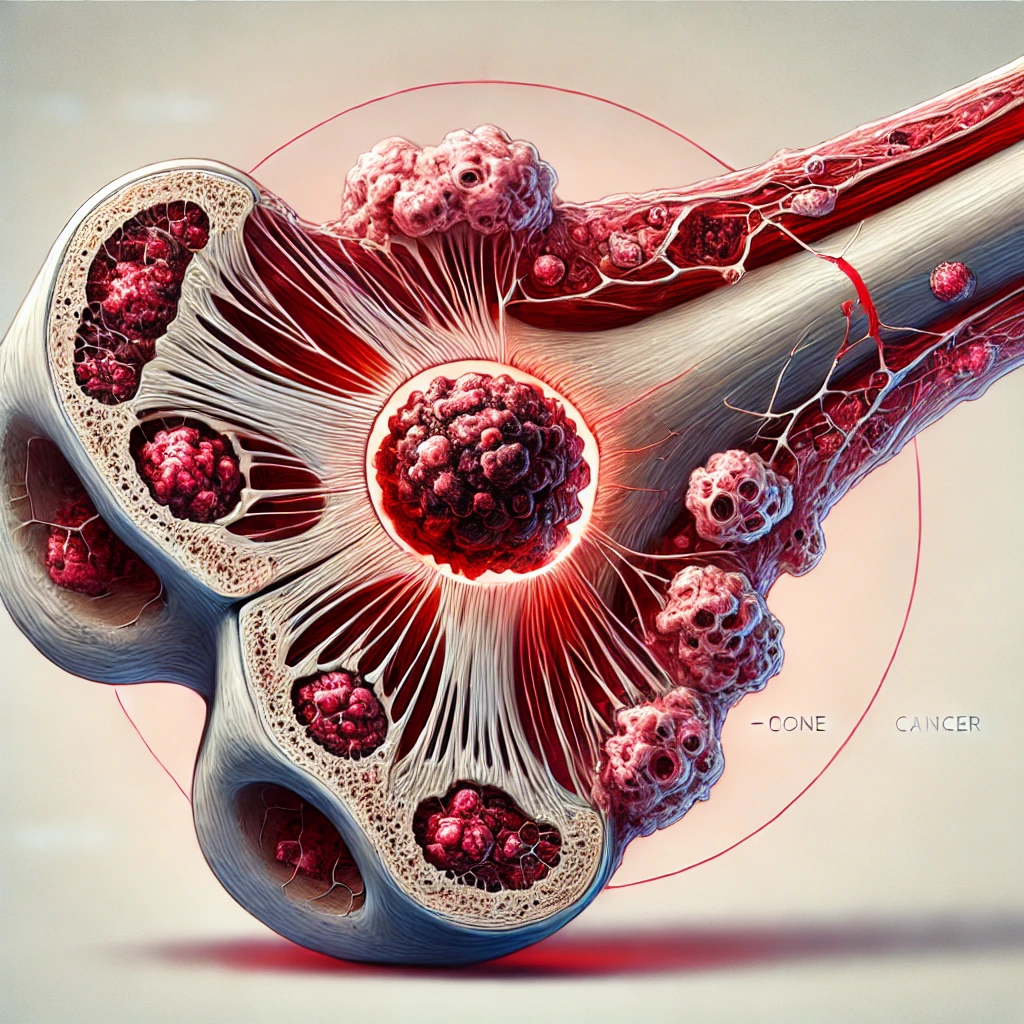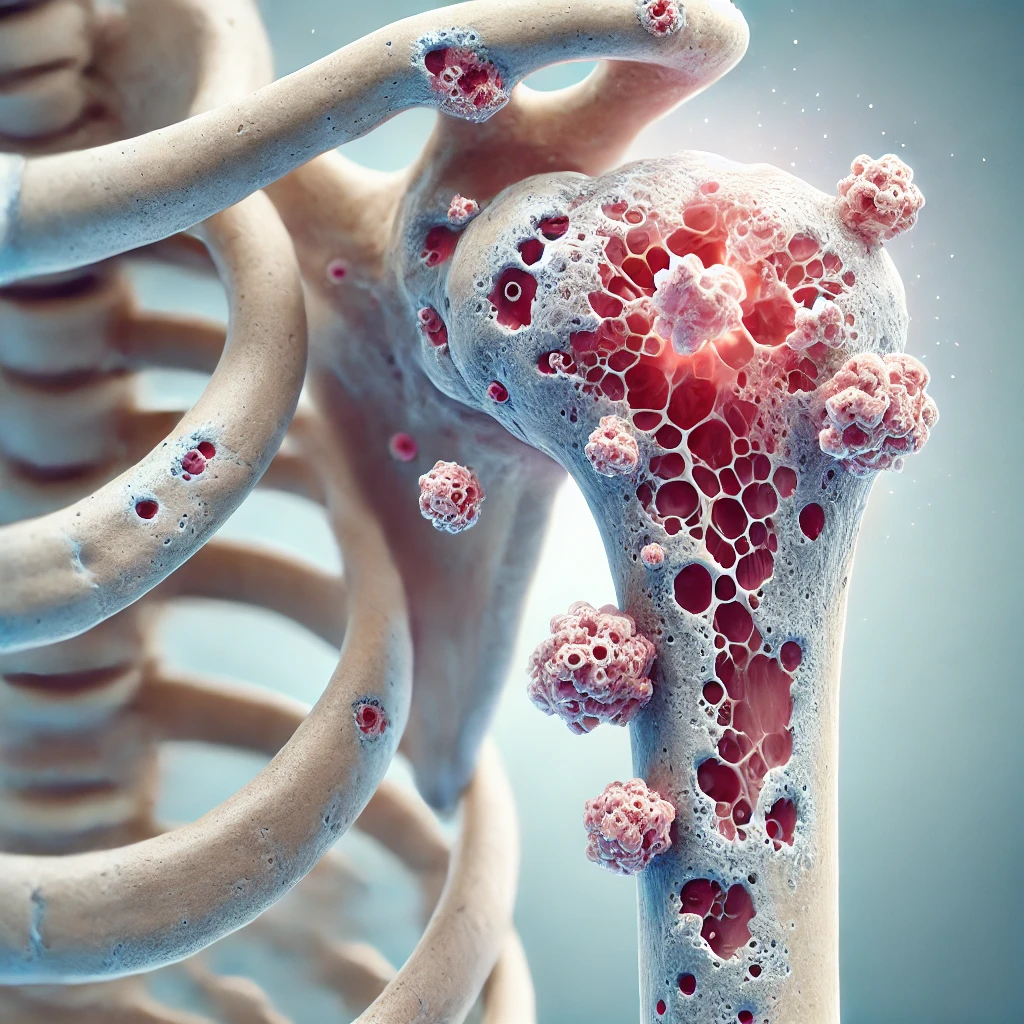Osteosarcoma, a rare form of bone cancer, is one of the most aggressive malignancies that primarily affects the bones. It most commonly occurs in the long bones, such as the arms and legs, but it can affect any bone in the body. Osteosarcoma primarily affects children, teenagers, and young adults, making it a critical concern for those in their formative years. It is characterized by abnormal cell growth in the bones, often resulting in pain, swelling, and, if left untreated, metastasis to other parts of the body, especially the lungs.
In the realm of cancer, early detection and treatment play a pivotal role in improving survival rates. Understanding the intricacies of osteosarcoma, including its causes, symptoms, stages, and treatments, is vital in the fight against this life-threatening disease.

What Causes Osteosarcoma?
Osteosarcoma originates in the bone-forming cells called osteoblasts, which are responsible for producing new bone tissue. While the exact cause of osteosarcoma remains unknown, several risk factors increase the likelihood of developing the disease:
1. Age: It most often affects people between the ages of 10 and 30, with a higher prevalence in teenagers.
2. Genetic Predisposition: Certain genetic conditions, such as Li-Fraumeni syndrome and hereditary retinoblastoma, can elevate the risk.
3. Radiation Exposure: High doses of radiation therapy, particularly during childhood, may increase the chances of developing osteosarcoma.
4. Paget’s Disease of Bone: This condition, more common in older adults, may also increase the risk of osteosarcoma in the elderly.
Despite these risk factors, many cases of osteosarcoma occur with no identifiable cause, highlighting the unpredictable nature of cancer development.
Early Symptoms of Osteosarcoma
The symptoms of osteosarcoma can be subtle at first, making early detection challenging. Some of the most common early signs to watch for include:
1. Bone Pain: Persistent pain in the affected bone, often worsening at night or during physical activity, is one of the earliest symptoms.
2. Swelling: As the tumor grows, swelling around the affected bone may occur, which could be mistaken for a sports injury or simple inflammation.
3. Limping: If osteosarcoma affects the leg, the patient may develop a limp or have difficulty walking.
4. Restricted Movement: In more advanced cases, the range of motion in the affected limb or joint may become limited.
These symptoms may not initially raise red flags, especially in teenagers, who are often involved in physical activities. However, persistent symptoms that do not improve with rest should be evaluated by a healthcare professional.
Stages of Osteosarcoma
Osteosarcoma, like other cancers, is staged based on the size of the tumor, its spread, and the aggressiveness of the cancer cells. The stages are crucial in determining the prognosis and treatment plan.
1. Stage 1 (Localized): In the earliest stage, the tumor is confined to the bone, and the cancer cells are less aggressive. It is often called low-grade osteosarcoma. The prognosis at this stage is generally good if the cancer is detected early and treated appropriately.
2. Stage 2 (Localized but Aggressive): Here, the tumor is still localized to the bone, but the cancer cells are more aggressive. High-grade osteosarcoma at this stage may require more intensive treatment to prevent spread.
3. Stage 3 (Spread to Nearby Areas): At this stage, the tumor has grown beyond the bone and may have spread to nearby tissues or joints. It is still considered localized but is more complex to treat due to the involvement of surrounding areas.
4. Stage 4 (Metastatic Osteosarcoma): The cancer has spread beyond the original bone to other parts of the body, most commonly the lungs. Metastatic osteosarcoma is the most challenging stage to treat, and the prognosis significantly declines as the cancer advances.
Challenges Faced by Osteosarcoma Patients
Osteosarcoma poses numerous challenges for patients, both physically and emotionally:
1. Intense Pain: Persistent and severe pain is one of the most challenging aspects of living with osteosarcoma. Pain management becomes a critical part of the treatment plan.
2. Mobility Issues: As the cancer affects bones, especially in the legs or arms, patients may experience difficulty with movement and physical tasks. In severe cases, amputation may be required, impacting the patient’s quality of life.
3. Emotional Strain: Being diagnosed with cancer at a young age can be emotionally devastating. Fear, anxiety, and uncertainty about the future weigh heavily on patients and their families.
4. Treatment Side Effects: Chemotherapy and radiation therapy, the most common treatments for osteosarcoma, come with side effects such as nausea, fatigue, and hair loss, making recovery even more difficult.
Treatment Options for Osteosarcoma
The treatment of osteosarcoma often involves a combination of surgery, chemotherapy, and sometimes radiation therapy. The choice of treatment depends on the stage of cancer, the location of the tumor, and the overall health of the patient.
1. Surgery: The primary goal of surgery is to remove the tumor and the surrounding affected tissues. In some cases, limb-sparing surgery can be performed to avoid amputation, where the tumor is removed without removing the entire limb. In more severe cases, however, amputation may be necessary to control the cancer’s spread.
2. Chemotherapy: Chemotherapy is a cornerstone of osteosarcoma treatment and is often used before and after surgery to shrink the tumor and destroy any remaining cancer cells. Drugs such as methotrexate, doxorubicin, and cisplatin are commonly used in chemotherapy regimens for osteosarcoma.
3. Radiation Therapy: Though osteosarcoma is generally resistant to radiation, it may be used in cases where surgery is not possible or to relieve symptoms such as pain in advanced stages.
4. Targeted Therapy: In recent years, targeted therapies that focus on specific molecules involved in cancer growth have shown promise in treating osteosarcoma. These therapies aim to minimize damage to healthy cells while effectively targeting cancer cells.
5. Clinical Trials: Many patients, particularly in advanced stages, may consider enrolling in clinical trials that offer access to new, experimental treatments. Clinical trials can provide patients with additional options when standard treatments prove ineffective.
Coping with Osteosarcoma: Emotional and Practical Support
Living with osteosarcoma can be overwhelming, and emotional support is crucial in coping with the challenges of cancer. Many patients benefit from support groups where they can connect with others going through similar experiences. Counseling, therapy, and peer support can make a significant difference in maintaining a positive outlook.
In addition, maintaining a healthy lifestyle, including proper nutrition, regular physical activity (as recommended by healthcare providers), and mindfulness practices, can help patients manage the stress of treatment and recovery.
Preventive Measures and Long-Term Outlook
While there is no guaranteed way to prevent osteosarcoma, awareness of the early symptoms and risk factors can lead to earlier detection and better outcomes. Individuals with a family history of cancer or genetic predispositions should remain vigilant and consult healthcare professionals for regular screenings if they are considered high-risk.
The long-term outlook for osteosarcoma patients depends largely on the stage at which the cancer is diagnosed and how well it responds to treatment. For those diagnosed at an early stage, the survival rate is significantly higher, with many patients achieving long-term remission. However, advanced or metastatic osteosarcoma presents a more complicated prognosis, requiring aggressive treatment and ongoing monitoring.
READ MORE-how to prevent colon cancer

Conclusion
Osteosarcoma is a challenging and aggressive form of bone cancer, but with early detection, modern treatment options, and comprehensive support, patients can improve their chances of survival and quality of life. Advances in medical research continue to provide hope for better treatments and outcomes, and awareness of this disease is key to helping those affected.
